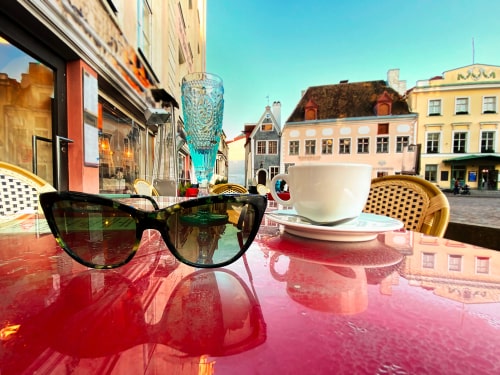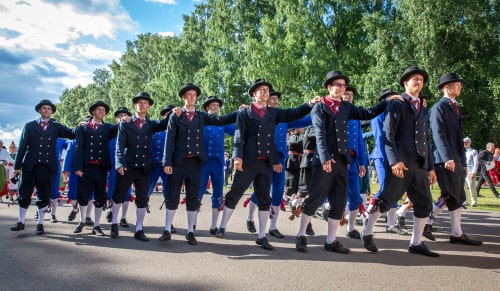Last updated on June 22nd, 2021
Facts about Estonia’s religion, culture, history, technology, people, economy, and flag.
27. Almost 19% of Estonians are unemployed.
28. Estonian population is declining. It has a birth rate of 10.51 births per 1,000 population.
29. The flag of Estonia contains three colors: blue, black and white. Blue represents – faith, loyalty, and devotion; black symbolizes – dark past and suffering, the soil of the country; and white denotes the quest to strive towards virtue and enlightenment.
30. It is interesting for the kids to note that Estonia has also been described as one of the most internet-focused countries in Europe.

31. Café culture is quite popular in the country. Cafes can be found in almost every corner and street across the country. The cafes in the country are small, cozy and provide a home-like feeling to its customers.
32. Estonia is a developed country with a high-income economy and high standard of living.
33. During your visit to Estonia, do not be amazed to find internet access even in the woods. Remember, we told you that Estonia is an internet-focused country.
34. Estonian schools are connected to the Internet. The Internet is everywhere in the country!
35. It is also the first country in the world to have used the internet for political voting. The Estonian parliamentary elections were conducted online in 2007 for the first time in the world.
36. Estonia has a literacy rate of 99.8%, which makes it rank second in the world for that matter.
37. They host a wife-carrying competition every year. Many European countries participate in this event. The male contestants have to carry their female counterparts and run through the obstacle course in the least possible time.

38. Radiocarbon dating suggests that “the Pulli settlement”, the oldest settlement in Estonia, was settled around 11,000 years ago.
39. One-fifth of the mainland area of Estonia is covered with Bogs and Mires.
40. If you want to greet someone in Estonia with a “Hello”, you had say them “tere”. It means Hello in Estonian.
41. Folk song lovers, please pay attention to this fact. Estonia has the highest collection of written folk songs in the world – 133,000.
42. Estonia does not accept dual citizenship.
43. Estonia has one of the highest rates of mobile phone ownership per capita. With a mobile phone, you could pay for virtually anything. Free Wi-Fi is also available across the country.
44. Drink and drive is not permissible in Estonia. They have zero tolerance for such offenders. The takeaway time for alcoholic beverages in shops is restricted to 10 pm.
45. The capital of Estonia–Tallinn–is voted as the best protected and intact medieval city in Europe.
46. You can also have a good chance to travel on ice roads if you visit the country during winters. Ice roads are formed between the mainland and the islands when the Baltic Sea freezes during winters.
47. Pay attention bird watchers, here is something of interest for you. Estonia sees millions of migratory birds. At least 380 species of birds are spotted in Estonia annually. The bird watching season begins in early March in the country.
48. And the country is among the top three bird watching destinations in Europe for the number of species spotted here.

Estonia facts for kids
49. Lake Peipsi is Estonia’s largest lake and Europe’s fourth largest freshwater lake.
50. Prior to 1921, Estonia was also spelled as “Esthonia”. Noticed the difference in the spelling?
51. The capital city has an area of approximately 159 sq km.
52. The Estonian territory consists of a mainland and islands and islets in the Baltic Sea.
53. The country was once ruled by the Danish, the Swedish, the Germans, and the Russians.
54. In the area, Estonia is about twice the size of New Jersey.
55. It has a total of 657 kilometers of land boundaries.
56. It is a democratic parliamentary republic.

57. Estonians celebrate their independence twice a year. Once on the 24th of February and the other on the 20th of August.
Estonia – country at a glance
| Independence | 20 August 1991 (declared); 6 September 1991 (recognized by the Soviet Union) |
|---|---|
| Capital City | Tallinna |
| Largest City | Tallinna |
| Area | total: 45,228 sq km land: 42,388 sq km water: 2,840 sq km |
| Population | 1,355,420 (2024 est.) |
| Demonym | Estonian |
| Official Language | Estonian |
| Borders | Latvia, Russia and Finland. |
| Suffrage | 18 years of age; universal; age 16 for local elections |
| Literacy | 99.9% (2021 est.) |
| Life expectancy at birth | 78.4 years (2024 est.) Life expectancy at birth indicates the number of years a newborn infant would live if prevailing patterns of mortality at the time of its birth were to stay the same throughout its life. |
| Currency | Euro (€) (EUR) |
| Religion | Lutheran Church (majorly a non-religious nation) |
| Climate | maritime; wet, moderate winters, cool summers |
| Terrain | marshy, lowlands; flat in the north, hilly in the south |
| Mean elevation | 61 m |
| Lowest point | Baltic Sea 0 m |
| Highest point | Suur Munamagi 318 m |
| Natural resources | oil shale, peat, rare earth elements, phosphorite, clay, limestone, sand, dolomite, arable land, sea mud |
| Agricultural land | 22.2% |
| Birth rate | 8.2 births/1,000 population (2024 est.) |
| Death rate | 13.2 deaths/1,000 population (2024 est.) |
| Sex ratio | 0.89 male(s)/female (2024 est.) |
| National symbols | barn swallow, cornflower |
| National anthem | "Mu isamaa, mu onn ja room" (My Native Land, My Pride and Joy) |
| Government type | parliamentary republic |
| President | Alar Karis |
| Prime Minister | Kristen Michal |
| National colors | blue, black, white |
| National holiday | Independence Day, 24 February (1918); note - 24 February 1918 was the date Estonia declared its independence from Soviet Russia and established its statehood; 20 August 1991 was the date it declared its independence from the Soviet Union |
| Industries | food, engineering, electronics, wood and wood products, textiles; information technology, telecommunications |
| Exports | $31.939 billion (2023 est.) electricity, broadcasting equipment, refined petroleum, wood, coal tar oil (2022) |
| Imports | $31.701 billion (2023 est.) refined petroleum, cars, electricity, natural gas, coal tar oil (2022) |
| GDP - per capita (PPP) | $42,000 (2023 est.) |
| Time Zone | IST (UTC+05:30) |
| Internet country code: | .ee |
| Calling Code | +372 |
| Drives on the | Right |
| Table last updated | October 24, 2024 |
